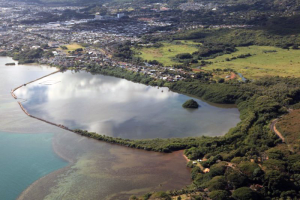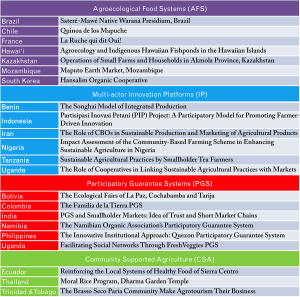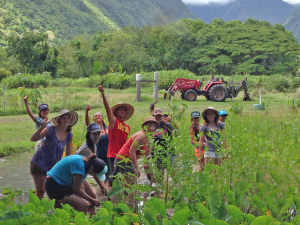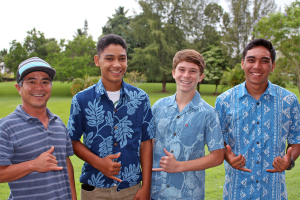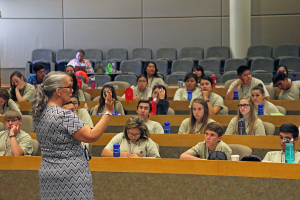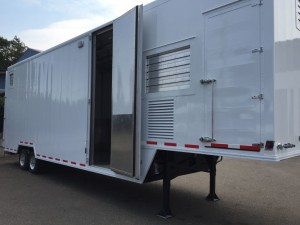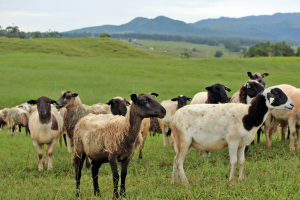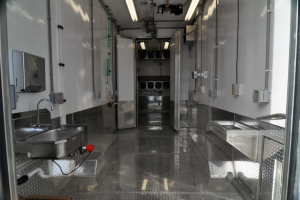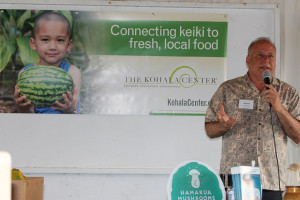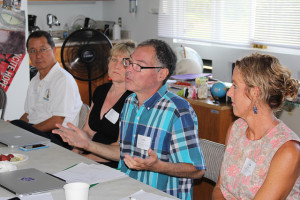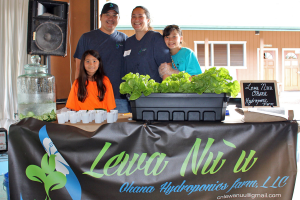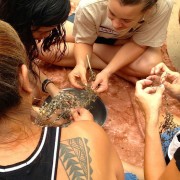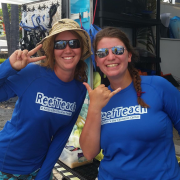IN THIS ISSUE:
A seat at the table: Representing Hawai‘i and the Pacific at the Food and Agriculture Organization of the United Nations
From Hilo to the Heartland: Ag interns advance ancestral knowledge
Mobile slaughter unit set to beef up local meat supply
Charting a course for locally grown food in Hawai‘i’s schools
Program news
A seat at the table: Representing Hawai‘i and the Pacific at the Food and Agriculture Organization of the United Nations
Shortly after we announced the selection of Dr. Kamanamaikalani Beamer as our new president and CEO earlier this year, he received an unexpected honor: an invitation to represent The Kohala Center, Hawai‘i, and Pacific communities at a meeting of global indigenous leaders at the Food and Agriculture Organization (FAO) of the United Nations.
Beamer, representing The Kohala Center and Hawai‘i, with Hinewirangi Kohu Morgan, representing Aotearoa (New Zealand) at the Food and Agriculture Organization of the United Nations in Rome, Italy, in February.
As FAO was preparing to convene a meeting of global indigenous leaders at its headquarters in Rome, Italy, a designated representative from the Pacific region became unavailable to attend. Given his vast knowledge of traditional Hawaiian agricultural practices, resource management, and agroecology, Beamer was recommended to represent Pacific indigenous communities at the gathering.
The meeting, “Indigenous Food Systems, Agroecology and the Voluntary Guidelines on Tenure,” brought together 20 UN representatives, political leaders, technical experts, and indigenous food producers from around the world. Many of the discussions focused on ways in which FAO could work with indigenous communities more effectively, the importance of recognizing agroecology and ancestral knowledge to preserve indigenous food systems and production practices, and how the UN’s Declaration on the Rights of Indigenous Peoples impacts FAO’s priorities and responsibilities.
“While it was incredible to meet so many passionate and influential native leaders from all over the world, the highlight for me was hearing attendees from regions vastly different from Hawai‘i, as well as FAO Director-General José Graziano da Silva, espouse values and solutions so closely aligned with The Kohala Center’s strategic approach to achieving greater food self-reliance,” Beamer said. “To hear representatives from places as different and far away as Central Africa and Siberia essentially agree that small family farms, biodiversity, agroecology, and indigenous knowledge and practices are vital to achieving global food security and eradicating malnutrition actually gave me ‘chicken skin.’ It made me realize that as we advance these approaches in Hawai‘i, we’re not operating in a bubble. The broader value systems that we have in Hawai‘i and Hawaiian culture are actually aligned with what communities in other corners of the world are advocating and seeing success with as well.”
It was Beamer’s first invitation to represent indigenous Pacific communities at FAO, and he sensed a few hours into the meeting that much of what he was contributing to discussions wasn’t resonating with some of the other leaders in attendance. “It occurred to me that many of my peers probably had a perception of Hawai‘i as a developed, secure society that benefits from its affiliation with the United States,” Beamer said. “Once I began to explain that Hawai‘i imports nearly 90% of our food from at least 2,300 miles away, how vulnerable we are to potential delivery disruptions, and some of the barriers we face in expanding local infrastructure to support increased food production, they began to appreciate Hawai‘i’s unique challenges. At that point they became more interested in the creative solutions we at The Kohala Center and other organizations in the Hawaiian Islands are implementing.”
An aerial view of He‘eia Fishpond on O‘ahu. The 88-acre fishpond was built 600 to 800 years ago and is productive today under the management of Paepae o He‘eia. (Photo courtesy Kalei Nu‘uhiwa)
Beamer cited lo‘i kalo (irrigated taro ponds), dryland field systems, and loko i‘a (fishponds) as examples of highly productive Native Hawaiian agriculture systems. FAO representatives expressed interest in loko i‘a and invited us to develop a case study as part of a global initiative examining 20 different agroecological food production and distribution efforts around the world. “Agroecology and Indigenous Hawaiian Fishponds in the Hawaiian Islands” will investigate how loko i‘a once produced an estimated 1.9 to 2.3 million pounds of fish per year, how they are being revitalized today to carry forward ancestral knowledge and increase community sustenance and food security, the cultural and ecological values associated with them, and distribution opportunities and market demands. The case study will largely focus on Paepae o He‘eia, a nonprofit dedicated to restoring and managing He‘eia Fishpond, an 88-acre kuapā (walled) fishpond on O‘ahu. Since 2001, Paepae o Heʻeia has used agroecologial techniques to revitalize the fishpond, and offers community programs focused on restoration, education, and production. Today the pond and its stewards produce several marine species including moi (Pacific threadfin), ʻawaʻawa (striped mullet), and limu (native algae), and will soon harvest its first oysters. Most of these products are sold to local restaurants and retail markets that purchase from Paepae o Heʻeia in part because of the organization’s sustainable farming practices and its broader social justice mission.
Loko i‘a (traditional Hawaiian fishponds) are the focus of one of 22 case studies being undertaken by FAO around the world. (Click to expand)
In June, Beamer traveled to a three-day meeting of case study researchers and practitioners in Bogotá, Colombia, to provide an update on our research and findings to date and learn about the other case studies in progress. “The breadth of the case studies is fascinating,” Beamer said. “Research partners are profiling ethical rice cultivation approaches in Thailand, participatory governance and organic certification systems in Africa and India, and how indigenous communities in the Andes are organizing their agroecological systems to enter consumer markets in creative ways. It was inspiring to see how regions are seeking to develop their rural economic structures around farming and increase their support of small family farms. I’m hopeful that this work will provide rural communities with innovative ideas that encourage more egalitarian production efforts, sharing of resources, and improve economic and food security.”
As we continue to work for increased food production and security in Hawai‘i, our partnership with FAO will enable us to forge alliances with international experts and organizations to share best practices and innovative solutions to our local and shared challenges. Not only can Hawai‘i benefit from the indigenous knowledge and agroecological successes of other societies on Earth, the ‘āina (land) and ancestral knowledge of our islands have much to share with the world as well. We look forward to sharing new knowledge with our communities, supporters, and partners in the months and years ahead—for a more resilient and self-reliant Hawai‘i.
From Hilo to the Heartland: Ag interns advance ancestral knowledge
When three high school students from Hilo made plans to attend our Sustainable Agriculture Internship Program this summer, they had no idea the experience would lead them several weeks later to a prestigious agriculture leadership summit for native youth in an unfamiliar and faraway land: Arkansas.
Participants in our Sustainable Agriculture Internship Program spend a day learning about traditional kalo (taro) cultivation at a lo‘i kalo (irrigated taro pond) in Waipi‘o Valley.
Created in 2013 in partnership with Kamehameha Schools’ ‘Āina Ulu Program, our Sustainable Agriculture Internship Program has introduced 57 Hawai‘i Island high school students and recent graduates to hands-on farm work, successful food production businesses, and the necessity to build and strengthen local food systems. This summer 26 students from Kamehameha Schools, Ke Kula ‘O Nāwahīokalani‘ōpu‘u, Kanu o ka ‘Āina, Kea‘au High, Hilo High, Waiākea High, Honoka‘a High, Parker School, and West Hawai‘i Explorations Academy participated in two-week paid internships, during which they worked on our Demonstration Farm in Honoka‘a, embarked on service-learning field trips to island farms and food production facilities, and learned about Native Hawaiian land stewardship practices and farming systems. They also learned how to grow, harvest, and prepare locally grown food, and propagated plants to start their own gardens at home.
“The Sustainable Agriculture Internship Program was created to give island youth a better sense of where their food comes from, introduce them to career opportunities in agriculture, and inspire them to become part of the solution to grow and produce more food locally,” said Derrick Kiyabu, director of our Beginning Farmer-Rancher Development Program. “Our farmer training program helps to prepare adults who’ve made the decision to start a farm or ranching business, while our high school intern program is intended to inspire a new generation of local food producers to lead us into the future.”
Beginning Farmer-Rancher Development Program director Derrick Kiyabu (left) poses with Summer 2015 ag interns (from left to right) Aukelenui Mortenson, Jonah Kim, and Ku‘ilua Mortenson.
Just as brothers Ku‘ilua and Aukelenui Mortensen and their friend Jonah Kim were wrapping up their internships in our program’s sixth cohort in June, they learned about a Native Youth In Agriculture Leadership Summit sponsored by the Indigenous Food and Agriculture Initiative at the University of Arkansas School of Law. “Our mom got an email just a few days before the application deadline and asked us if this sounded like something we wanted to do,” recalled Aukelenui, who recently started his junior year at Kamehameha Schools’ Kea‘au campus. “The three of us had a good time and learned a lot in The Kohala Center program so we thought ‘why not?’ and decided to apply together, just to see what would happen.”
Kiyabu wrote letters of support to accompany their applications. Within a few weeks, the three young men had been accepted to the intensive program and were on their way to Fayetteville, Arkansas to join 79 other Native Hawaiian, Alaska Native, and American Indian youth for eight days of classroom instruction, field trips, leadership development, and sharing indigenous knowledge.
According to Ku‘ilua, a recent graduate of Ke Kula ‘O Nāwahīokalani‘ōpu‘u, the two programs complemented each other despite being vastly different. “The Kohala Center program was really hands-on in that we got to do a lot of farm work, go on field trips, and meet local farmers and agriculture professionals. It got the three of us pretty excited about farming and made us want to learn more. In Arkansas we got to meet people our age from farming families and learn about their lives on the mainland. We spent a lot of time in classroom lectures, learning more about the business and legal side of farming. Being on a college campus it also gave us a sense of what college would be like: we’d get up early, attend lectures, learn a lot very quickly, study together, go to bed, and do it all over again the next day.”
Janie Simms Hipp leads a discussion about legal issues in agriculture at the Native Youth In Agriculture Leadership Summit held at the University of Arkansas. A visiting assistant professor of law at the university, Hipp is the director of the Summit and of the Indigenous Food and Agriculture Initiative. (Photo courtesy Yen Nguyen/University of Arkansas School of Law)
The Arkansas program also introduced the young men to American Indian culture, as well as to challenges shared by native peoples in Hawai‘i and the continental U.S. “The Summit in Arkansas made me realize how much Native Hawaiians and Native Americans have in common,” said Jonah, who recently started his junior year at Ke Kula ‘O Nāwahīokalani‘ōpu‘u. “We’re all native peoples, isolated in similar ways and facing a lot of the same educational, health, and economic challenges. And we’re all in this stage of trying to lift ourselves and our communities up, break free of barriers that have kept us down, and let people know that our knowledge can have a big impact on the world.”
The summer experiences also instilled a sense of urgency. “We need to start now as young leaders to share this knowledge,” Aukelenui said. “We need to take what we’ve learned and make farming a priority so we can provide for ourselves and not be so dependent on others.”
“It’s all our kuleana (responsibility) to care for the ‘āina because it’s part of who we are,” Jonah chimed in. “Our ancestors did and we should too, because if we don’t take care of our land, there won’t be much of it left for the next generations. It’s up to all of us to take care of the land we all use and benefit from.”
The Mortensen brothers are contemplating college and community service opportunities after high school, with the goal of starting a family farm and agricultural business in Hawai‘i in the future. Jonah is also considering college and hopes to pursue a local career in either conservation forestry or aquaculture, cultivating edible native limu (algae, seaweed) varieties that are currently threatened by invasive species, overharvesting, and pollution.
All agreed that our Sustainable Agriculture Internship Program presents island youth with a valuable, hands-on opportunity to learn more about agriculture, connect with the ‘āina that sustains us, and join the movement to advance Hawai‘i toward greater food self-reliance. “I really liked the farm work, getting dirty and sweaty and feeling that sense of accomplishment at the end of the day,” Jonah said. “But the program also helped me see that we don’t need to be so dependent on the cargo ships that come to Hawai‘i. We can produce our own food. It might take some work, but it’s not impossible or so hard that it’s not worth trying.”
We are currently accepting applications for the Fall 2015 cohort of our Sustainable Agriculture Internship Program, which will take place during the public school intersession October 5–9. For more information and to apply visit koha.la/farminterns.
Mobile slaughter unit set to beef up local meat supply
Island residents, visitors, and chefs who have longed for more locally raised meat options will soon have their wishes come true: Hawai‘i’s first mobile slaughter unit (MSU) will begin operating on Hawai‘i Island early next year, offering ranchers and small-scale livestock producers humane, USDA-inspected processing of pigs, sheep, goats, and cattle.
Many meat producers on Hawai‘i Island face significant barriers to starting and maintaining their businesses. Despite its abundant ranch lands and ranching operations, the island currently imports 83% of its beef and more than 95% of its pork, lamb, and goat meats due to competition from imported meat products, high operational costs, and insufficient access to USDA-inspected slaughterhouses.
Hawai‘i Island Meat Cooperative’s mobile slaughter unit is expected to arrive on the island in September and begin operating in early 2016. (Photo courtesy Hawai‘i Island Meat Cooperative)
Hawai‘i Island Meat Cooperative (HIMC) is a new cooperative business created in response to the expressed needs of island ranchers for greater access to high-quality, humane, and convenient slaughter services. The co-op will operate the first truly mobile slaughter unit in the Hawaiian Islands, providing local livestock producers with USDA-inspected slaughter services on-site and at regional docking sites around the island.
The concept of an MSU was originally advanced by Big Island Resource Conservation & Development’s late president, Kawika Marquez, who assembled a task force in 2011. Marquez forged strategic partnerships with us and the Hawai‘i Small Business Development Center to conduct a feasibility study to determine the viability of such a service. The study found clear demand from producers, with more than 90 percent of those surveyed interested in using the unit and nearly 70 percent committed to investing their own money in the project.
The mobile unit will enable small-scale ranchers on Hawai‘i Island to process their goats, sheep, pigs, and cattle on-site in a USDA-inspected facility.
The feasibility study also suggested that employing a cooperative business model made the most sense because an MSU’s core purpose would be to provide unmet services for a large number of small meat producers rather than benefit any single individual. “Small-scale ranchers on this island tend to lack the capital needed to start a business of this scope,” said Dana Shapiro, one of our cooperative development specialists and HIMC’s project manager. “By working together they can leverage more financial capital, public support, bargaining power, and other resources than they could operating independently.” Membership dues provide co-ops with startup equity through the purchase of member common stock, which is refundable upon membership termination. Members have a say in shaping a co-op’s future by voting and electing board directors, benefit from having preferred access to using the co-op’s services, and share earnings based on patronage, or how much they use the co-op each year.
The Hawai‘i Department of Agriculture has championed the initiative as a project partner, providing the co-op with critical funding to order the unit, navigate legal and regulatory requirements, develop branding and marketing materials, and conduct trainings on butchering techniques. The 36-foot trailer was recently purchased from TriVan, the most experienced MSU manufacturer in the United States. Expected to arrive on the island in September and be placed into service in early 2016, the unit will be capable of processing 15 pigs, 30 lamb or goats, and eight to 10 head of cattle per day.
Our Rural Cooperative and Business Development Services team has assisted HIMC by incorporating the business as a Hawai‘i agricultural producer cooperative, assembling a producer steering committee, incubating and developing its cooperative structure, facilitating board formation and training, and providing grant writing and financial systems planning. Our communications team has also provided support by developing the co-op’s website and is currently assisting with marketing and brand development.
The interior of Hawai‘i Island Meat Cooperative’s mobile slaughter unit offers a clean, humane, and sanitary environment for on-site meat processing. (Photo courtesy Hawai‘i Island MeatCooperative)
Mobile units have increased in popularity worldwide in recent years because they are typically cheaper to build and operate than fixed facilities, more adaptable to the varying needs of diverse livestock operations, and allow for on- or near-farm slaughter, which many consider to be more humane than transporting animals long distances. More than two dozen such units currently operate in the U.S., with many managed by producer cooperatives formed specifically to operate slaughter services by and for area ranchers.
HIMC recently held several information sessions for producers interested in learning more about the MSU’s capabilities, how to access its services, and the benefits of becoming members of the co-op. The group will kick off a membership drive this fall at Taste of the Hawaiian Range on October 9, and at public sessions in Kailua-Kona on October 17 and Hilo on October 18. Membership applications will also be available on the co-op’s website.
“We’ve been pleasantly surprised by the level of interest expressed by local ranchers and the community in general,” said Mike Amado, HIMC’s board president. “Clearly there’s demand for a more sensible, self-sustaining model of production and distribution for locally sourced meat products. It’s a strong affirmation of all the hard work by many people dedicated to this effort over many years.”
The Hawai‘i Island Meat Cooperative and its MSU are welcome additions to Hawai‘i’s rural business community and agricultural infrastructure. The effort will provide a complement to the island’s existing slaughter services, support the ongoing revitalization of local family farms and ranches essential to increasing Hawai‘i’s food security, and serve as a model for future meat-production endeavors on other islands.
To learn more about Hawai‘i Island Meat Cooperative, become a member, or join its mailing list to stay informed of the co-op’s progress and products, visit HawaiiIslandMeat.com or email HawaiiIslandMeat@gmail.com.
Charting a course for locally grown food in Hawai‘i’s schools
The farm to school movement continues to gain momentum in Hawai‘i, as numerous agriculture and education stakeholders work toward increasing procurement of fresh, locally grown for school meals and snacks. Our recent efforts to guide the development of a charter school food cooperative on Hawaiʻi Island could serve as a model to advance farm to school across the islands.
All of Hawai‘i’s 289 public and charter schools belong to one massive school district spanning six islands. School food purchasing decisions for Hawaiʻi’s 255 regular public schools are centralized within the Hawaiʻi State Department of Education’s School Food Services Branch (SFSB). Current policy and the fact that Hawai‘i imports nearly 90% of its food from thousands of miles away pose significant barriers to SFSB being able to source locally produced food on a consistent basis.
Hawai‘i State Senator Russell Ruderman addresses charter school personnel, farmers, and food producers at our “Meet Your Farmer” mixer in Pāhoa, June 30, 2015.
Hawai‘i’s 34 public charter schools, on the other hand, can be at the vanguard of farm to school food procurement because they have more autonomy and flexibility than regular public schools when it comes to food procurement. In 2013, charter schools that didn’t share cafeteria facilities with a nearby public school became responsible for managing their own school food programs, essentially making them their own food authorities. While many charter schools initially saw the policy shift as a burden, others saw creative opportunities to build farm to school programs at the individual school level. As charter schools in our Hawai‘i Island School Garden Network (HISGN) began to share their approaches and successes with us and each other, we convened a Charter School Food Working Group in June 2014 to facilitate dialogue and collaboration, encourage participation in federal child nutrition programs such as USDA’s Fresh Fruit and Vegetables Program (FFVP), build capacity, and connect with local farmers and distributors to source more Hawai‘i-grown and produced food.
“Hawai‘i’s public charter schools have the potential to develop a local food procurement system that, if successful, could serve as a model for regular public schools throughout the islands,” said HISGN director Nancy Redfeather. “Our charter schools are in an ideal position to demonstrate how a farm to school model truly can work.”
A number of charter schools have expressed interest in buying more local food, either directly from island farmers and food producers or through food hubs and distributors. As our rural business development specialist Anna-Lisa Okoye explains, “increasing local food procurement via direct farm sales or through aggregators is certainly possible, but doing so requires advance planning and relationship building to align school food menus and local food production.” Most of Hawai‘i’s farms are small, family-owned operations, and current production levels may require piloting farm to school procurement programs at individual schools or small groups of schools. “With proper coordination and public support, farm to school procurement could drive increases in local food production, with positive impacts on both community health and Hawai‘i’s rural economy.”
Chris Hecht, executive director of Kona Pacific Public Charter School, explains how a co-op could procure locally grown food for school meals, reduce costs, and streamline administrative functions at a Charter School Food Working Group meeting held June 30, 2015 in Pāhoa.
At a June meeting of our Charter School Food Working Group at the Hawai‘i Academy of Arts and Science in Pāhoa, 12 representatives from six Hawai‘i Island charter schools, the office of Hawai‘i Child Nutrition Programs, and the Hawai‘i Public Charter Schools Network met to discuss charter school food programs. Usha Kotner and Chris Hecht of Kona Pacific Public Charter School presented their experiences in building a successful school food authority and farm to school program at their campus, and introduced the concept of creating a charter school food cooperative.
“Charter school leaders want to ensure that students are well fed, but must weigh the cost of operating nutrition programs in light of limited school funding,” said Hecht, Kona Pacific’s executive director. “A co-op would provide centralized administrative, menu planning, and training services for nutrition programs at lower cost, and further reduce costs through shared procurement.”
A lively and interactive “Meet Your Farmer” mixer was held following the meeting, enabling charter school personnel and three food aggregators that serve Hawaiʻi’s schools to establish meaningful connections with representatives from 15 Hawai‘i Island family farms. Farmers had the opportunity to share produce and value-added product samples with attendees and learn more about the requirements to sell to charter schools. Hawai‘i State Senator and local food champion Russell Ruderman addressed attendees and praised the group for advancing farm to school on a grassroots level, and also listened to concerns from small-scale farmers about the obstacles they face in selling their produce to institutional buyers.
The Nakamura family of Lewa Nu‘u ‘Ohana Hydroponic Farms in Kaūmana brought samples of lettuce and heart-shaped cucumbers.
“The event was a really wonderful experience for us,” said Keith Nakamura of Lewa Nu‘u ‘Ohana Hydroponics Farm in Kaūmana, who along with his wife Carmen and their children wowed attendees with their heart-shaped cucumbers. “We’d never been to something like this and we made some great contacts with local schools as well as distributors and other farmers. We even got advice on what we should try to grow and it was great talking story with other farmers and learning from their experiences.”
The Charter School Food Working Group will meet again on Hawai‘i Island on October 13 to begin to define the co-op’s structure and functions, map out participating schools’ annual menu cycles and ingredient needs, and discuss the logistics of launching this new endeavor. We are also planning a “Meet Your Farmer” mixer on O‘ahu later this year to connect school, farmers, and distributors. To learn more about the Charter School Food Working Group and the O‘ahu “Meet Your Farmer” mixer, contact Anna-Lisa Okoye at aokoye@kohalacenter.org or 808-887-6411.
Program news
We turn research and ancestral knowledge into action, so that communities in Hawai‘i and around the world can thrive—ecologically, economically, culturally, and socially. We accomplish this through our ‘āina-based programs for community well-being, created in direct response to the expressed needs and aspirations of island residents and community partners. Here’s some of the latest news from our programs and announcements of upcoming opportunities.
Teachers Teaching Teachers workshops continue this fall with several free professional development opportunities for educators and the community. Upcoming workshop topics include ‘Ai Pono: Connecting School Gardens to the Worldwide Voyage of Hōkūle‘a and Hikianalia in Kailua-Kona on August 29; Composting and Food Safety for School Gardens in Kealakekua on September 12; and a Seed Workshop and Community Exchange in Captain Cook on November 6. For more information and to register, contact Donna Mitts at dmitts@kohalacenter.org or 808-936-2117.
Representatives from our Hawai‘i Island School Garden Network and Rural and Cooperative Business Development Services teams will be participating in several working groups addressing agricultural education and farm to school efforts across the Hawaiian Islands. A new Agriculture Education Working Group chaired by Maria Gallo, dean of the University of Hawai‘i’s College of Tropical Agriculture and Human Resources, will meet regularly at UH Mānoa to develop a support framework for agricultural learning programs in Hawai‘i from pre-kindergarten through graduate school, as well as identify and build new partnerships to strengthen these connections. Some of our program staff will also be participating in farm to school working groups chaired by Hawai‘i Lt. Governor Shan Tsutsui and State Senator Suzanne Chun Oakland, which are exploring solutions to increase local food in school meals as well as ways to support Hawai‘i’s school garden and farm programs.
X
Participants clean seeds at a seed-saving workshop held on O‘ahu on August 8, 2015. (Photo courtesy Hawai‘i SEED)
Lyn Howe, coordinator of our Hawai‘i Public Seed Initiative, was the featured presenter at a workshop on O‘ahu earlier this month hosted by Hawai‘i SEED and Slow Food in Hawai‘i. Lyn shared tips on the best ways to save, clean, and store seeds, and also demonstrated our Seed Variety Selection Tool for the Hawaiian Islands to the 45 farmers, gardeners, and community members in attendance. The workshop also provided an opportunity for O‘ahu seed savers to develop a master plan for seed exchanges and to increase publicity and support on the island.
Friends of the Libraries, Kona (FOLK) will be opening a new community seed-lending library on September 15 at the Kailua-Kona Public Library. The free service is intended to encourage seed saving and sharing in the community. FOLK plans to hold workshops related to seeds and other aspects of gardening at the seed library throughout the year. Our Hawai‘i Public Seed Initiative team provided guidance on best practices, and hopes the seed-lending library will serve as a model for other libraries throughout the islands. To learn more or to volunteer, contact Natalie Guerin at Nehamah47@gmail.com.
X
Julie Dantas (left) and Marie Conan traveled from France to spend their summer interning at our Kahalu‘u Bay Education Center and our Demonstration Farm in Honoka‘a.
As part of their studies at École Nationale Supérieure des Technologies et Industries du Bois, an engineering school in France focused on wood as a sustainable construction and design material, students have to spend time overseas to improve their English. While researching internship opportunities abroad, students Julie Dantas and Marie Conan learned of The Kohala Center and were intrigued by the diversity of our ecology and sustainability programs. The young women chose to spend their summer on Hawai‘i Island interning at our Demonstration Farm in Honokaʻa for two months and at our Kahalu‘u Bay Education Center for one month. “I thought that working with The Kohala Center could show us a lot of things,” Dantas said. “This summer I got to learn about farming and vegetation in a different climate and culture, learn about marine animals, and communicate with the public by being a ReefTeacher.” At Kahalu‘u the young women snorkeled every morning to become more familiar with the bay, allowing them to share their experiences and enthusiasm with visitors. For Conan, working with us gave her the chance to gain knowledge and experiences different than, but related to, what she’s learning in school. “The common point between our studies and The Kohala Center is ecology,” Conan said. “Wood is a strategic material because it’s renewable, recyclable, and it contributes to the fight against climate change, but sustainable development won’t be possible if we don’t protect the health of our ecosystems.”
X
Our Kohala Watershed Partnership is appealing to the public for immediate support. Earlier this month, a runaway brush fire scorched nearly 2,000 acres of the Pelekane Bay watershed in Kawaihae. A massive flash flood a week later not only washed tons of ash and topsoil into the bay (threatening the health of coral reefs and other marine life along the South Kohala coastline), fencing erected by our field crew to keep feral goats out of the watershed was toppled and buried under sediment or completely washed away. As a result, goats are able to roam free in the watershed, threatening restoration and erosion-control efforts. The need to rebuild the fence is urgent and the Partnership needs to raise $30,000 to complete the work. Please consider making a tax-deductible donation to the Kohala Watershed Partnership online at koha.la/donate or by mailing a check to P.O. Box 437462, Kamuela, HI 96743.
X
2014–2015 doctoral fellow Dr. Noelani Puniwai successfully defended her dissertation, “‘Ike i ke au nui ke au iki: Assessing Cultural Seascapes in Hawai‘i,” in July, making her the 13th Native Hawaiian doctoral candidate in our Mellon-Hawai‘i Doctoral and Postdoctoral Fellowship Program to complete her Ph.D.
The University of Hawaiʻi Press Editorial Board has approved the publication of 2012–2013 doctoral fellow Dr. Marie Alohalani Brown’s manuscript, Facing the Spears of Change: The Life and Legacy of John Papa ʻĪʻī. Brown’s first book is inspired by her doctoral dissertation chronicling the life, career, and legacy of Ioane Papa ‘Ī‘ī.
X
Flyer for Cooperative Business Accounting Training on September 24 in Waimea.
Accountants, bookkeepers, and cooperative business managers and members are invited to register for our upcoming Cooperative Business Accounting Training. The one-day course will be held on Thursday, September 24 from 9:30 a.m. to 4:30 p.m. at Anna Ranch in Waimea, Hawai‘i Island, and provide an overview of cooperative business accounting and taxation. CPAs are eligible to receive up to six (6) hours of Hawaiʻi CPE credit. Full-day registration includes lunch and is $40 for co-op members and bookkeepers and $150 for accountants. Half-day workshop fees are $20 for co-op members and bookkeepers and $75 for accountants. Pre-registration is required by Tuesday, September 22. For more information and to register, visit koha.la/coopacct or call 808-887-6411.
This fall we’ll be presenting Wholesale Success, a series of two-day workshops covering food safety and production requirements for produce farmers seeking to enter wholesale markets. Seasoned producers, produce buyers, county sanitarians, farmers market masters, community and school garden coordinators, school and other institutional food-service directors, food processors, and extension agents are also encouraged to attend. Workshops will be held November 3–4 in Waimea, Hawai‘i Island; November 5–6 in Kahului, Maui, and November 9–10 in Ho‘olehua, Moloka‘i. Sign up for our biweekly Agricultural Resources Bulletins to receive more information.



